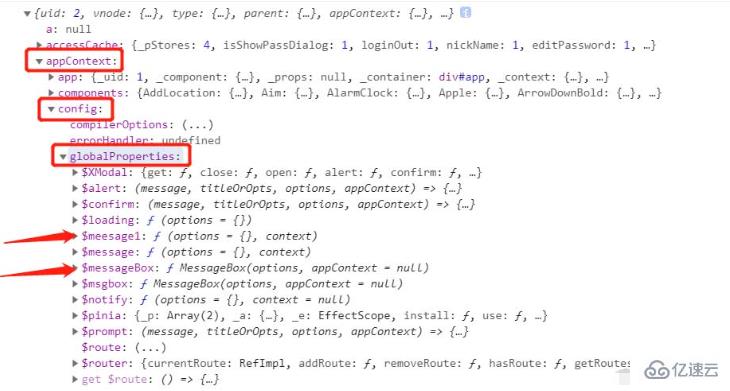溫馨提示×
您好,登錄后才能下訂單哦!
點擊 登錄注冊 即表示同意《億速云用戶服務條款》
您好,登錄后才能下訂單哦!
這篇“vue3怎么配置全局參數及組件”文章的知識點大部分人都不太理解,所以小編給大家總結了以下內容,內容詳細,步驟清晰,具有一定的借鑒價值,希望大家閱讀完這篇文章能有所收獲,下面我們一起來看看這篇“vue3怎么配置全局參數及組件”文章吧。
Vue.property.xxx
import Vue from "vue";
import axios from "axios";
Vue.prototype.$http= axios;
new Vue({
router,
store,
render: (h) => h(App),
}).$mount("#app");this.$http.xxx();
app.config.globalProperties.xxx
import { createApp } from 'vue'
import App from './App.vue'
import ElementPlus, { ElMessage, ElMessageBox } from 'element-plus'
import 'element-plus/dist/index.css'
const app = createApp(App);
app.config.globalProperties.$messageBox = ElMessageBox;
app.config.globalProperties.$message1 = ElMessage;// 引入vue的 getCurrentInstance 方法
import { defineComponent, getCurrentInstance } from "vue";
// 獲取當前組件實例
const { appContext } = getCurrentInstance();
// 打印看一下結構
console.log(appContext)
在appContext.config.globalProperties里面已經可以看到掛載的$messageBox和$message1了,至于為什么還有一個$message
我們可以看張element plus官網的截圖

可以看到這是element plus默認掛載的,我們可以直接使用,這里添加$message1只是演示,其實是可以直接使用默認掛載的。
完整使用例子
// 引入vue的 getCurrentInstance 方法
import { defineComponent, getCurrentInstance } from "vue";
// 獲取當前組件實例
const { appContext } = getCurrentInstance();
const globalProxy = appContext.config.globalProperties;
export default defineComponent({
setup() {
// 退出登錄按鈕
const loginOut = () => {
globalProxy.$messageBox.confirm("確定退出登錄嗎?", "提示", {
confirmButtonText: "確定",
cancelButtonText: "取消",
type: "warning",
})
.then(() => {
setTimeout(() => {
globalProxy.$message1({message: "已退出登錄", type: "success"});
localStorage.removeItem("userInfo");
router.push("/login");
}, 200);
})
.catch((e) => {
console.log(e);
});
};
return {
loginOut
}
}
})以上就是關于“vue3怎么配置全局參數及組件”這篇文章的內容,相信大家都有了一定的了解,希望小編分享的內容對大家有幫助,若想了解更多相關的知識內容,請關注億速云行業資訊頻道。
免責聲明:本站發布的內容(圖片、視頻和文字)以原創、轉載和分享為主,文章觀點不代表本網站立場,如果涉及侵權請聯系站長郵箱:is@yisu.com進行舉報,并提供相關證據,一經查實,將立刻刪除涉嫌侵權內容。